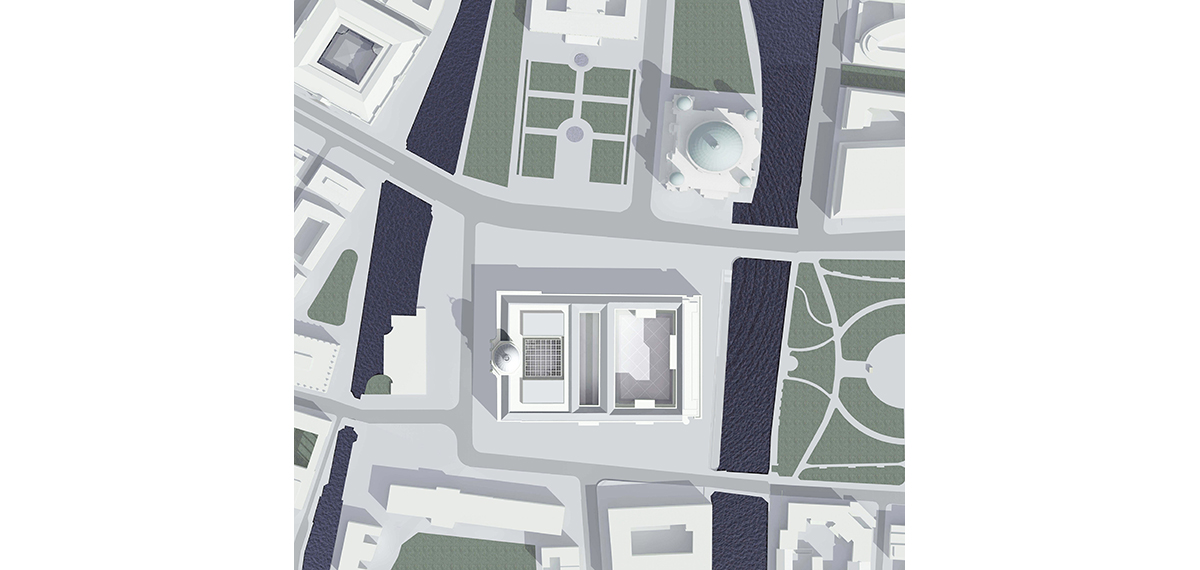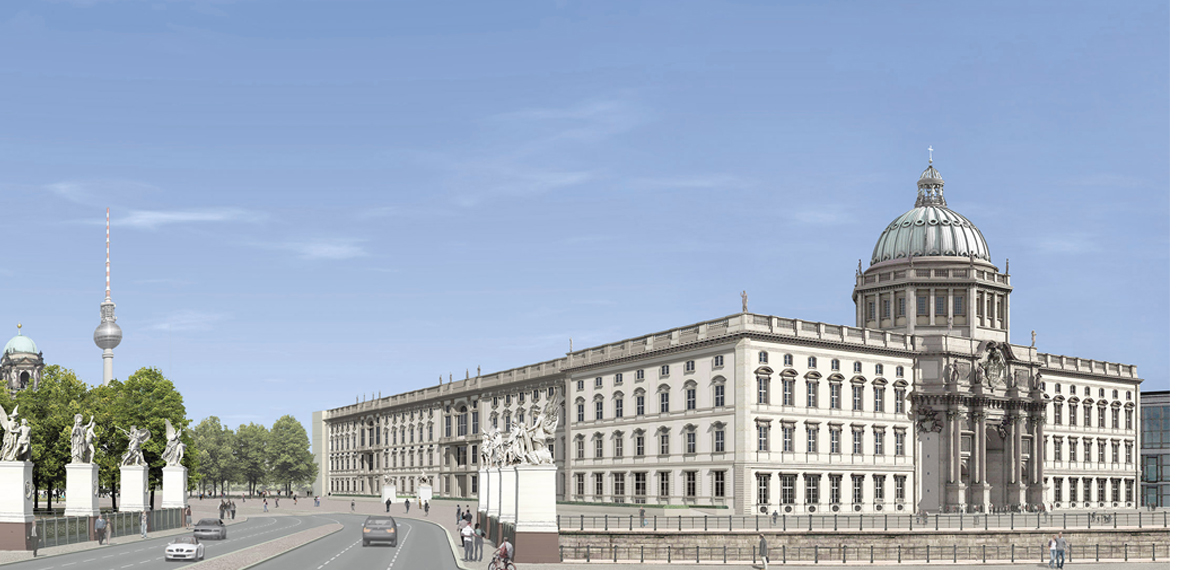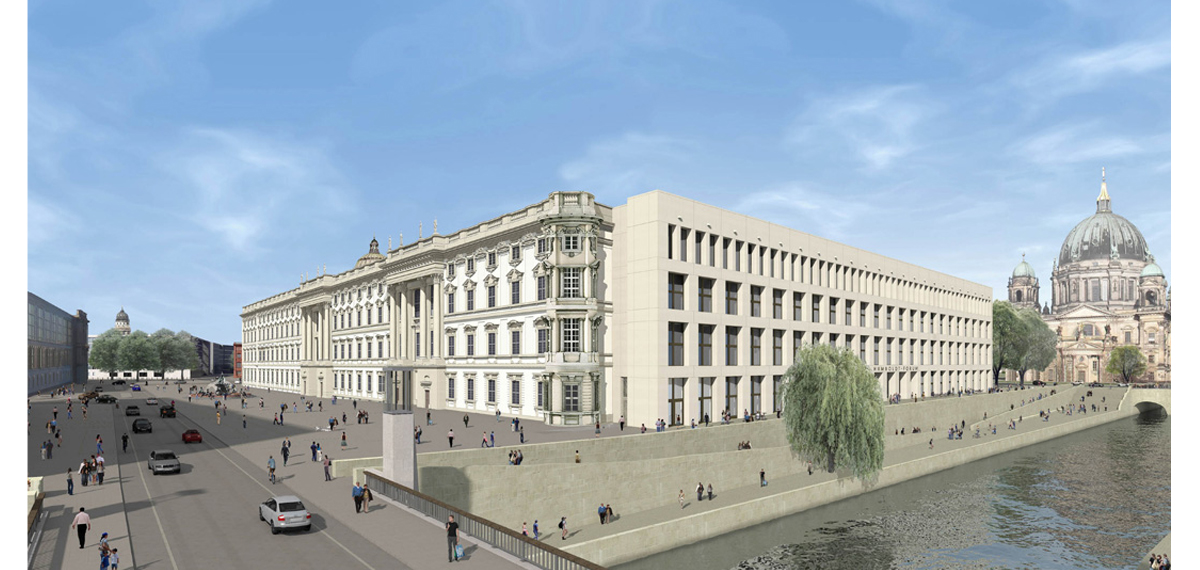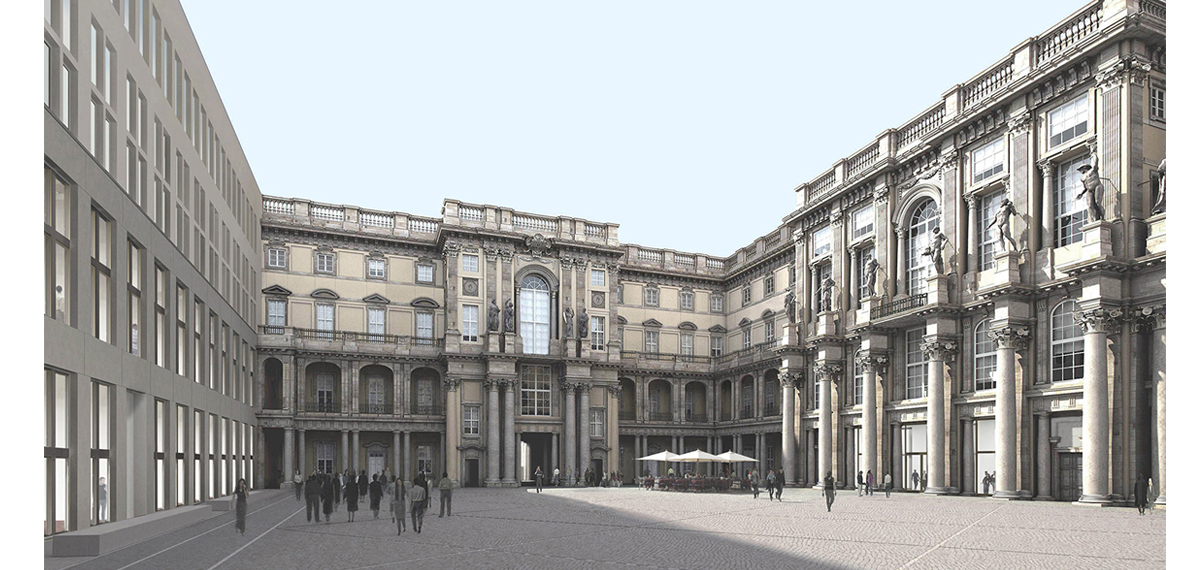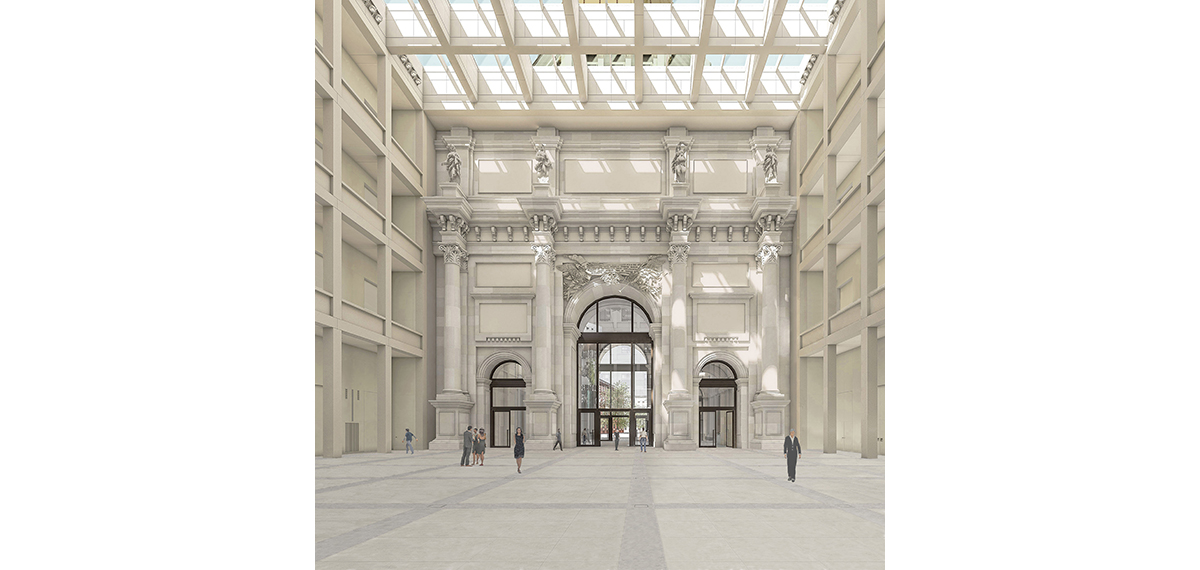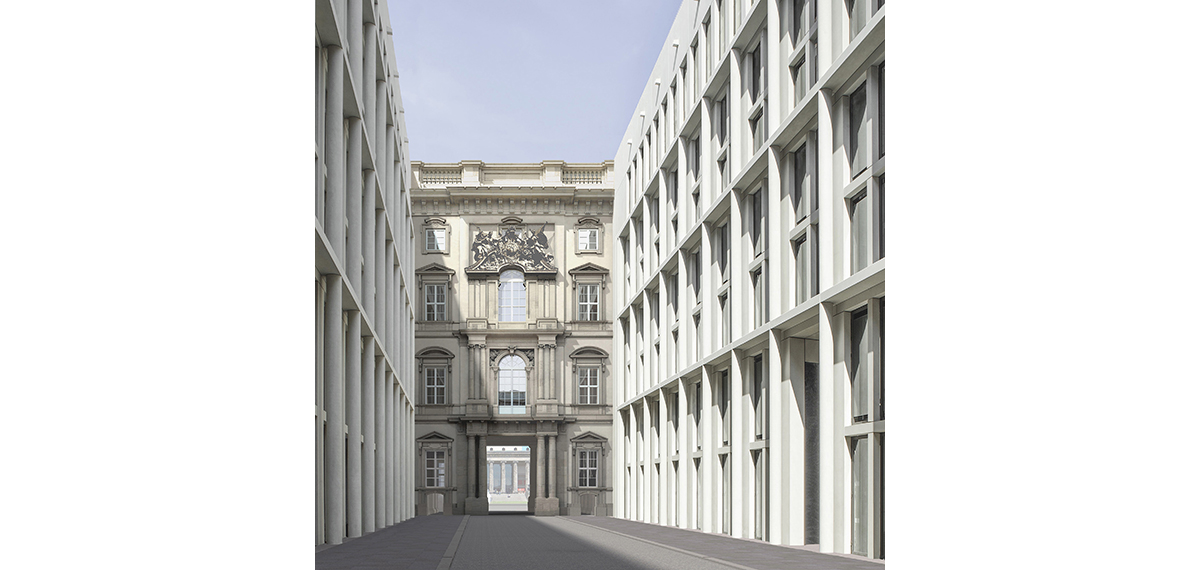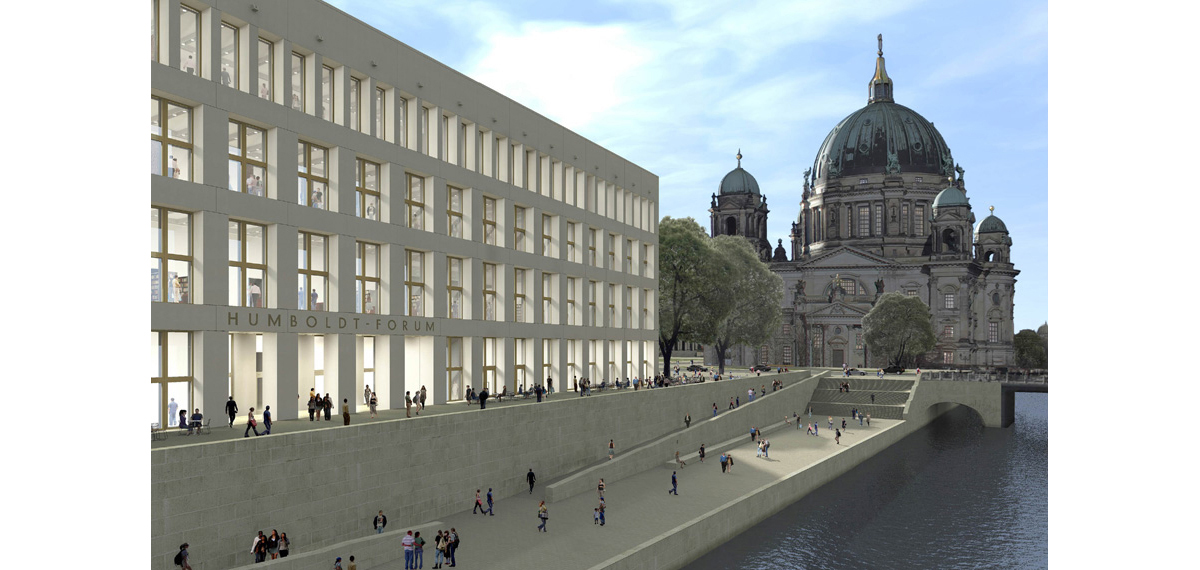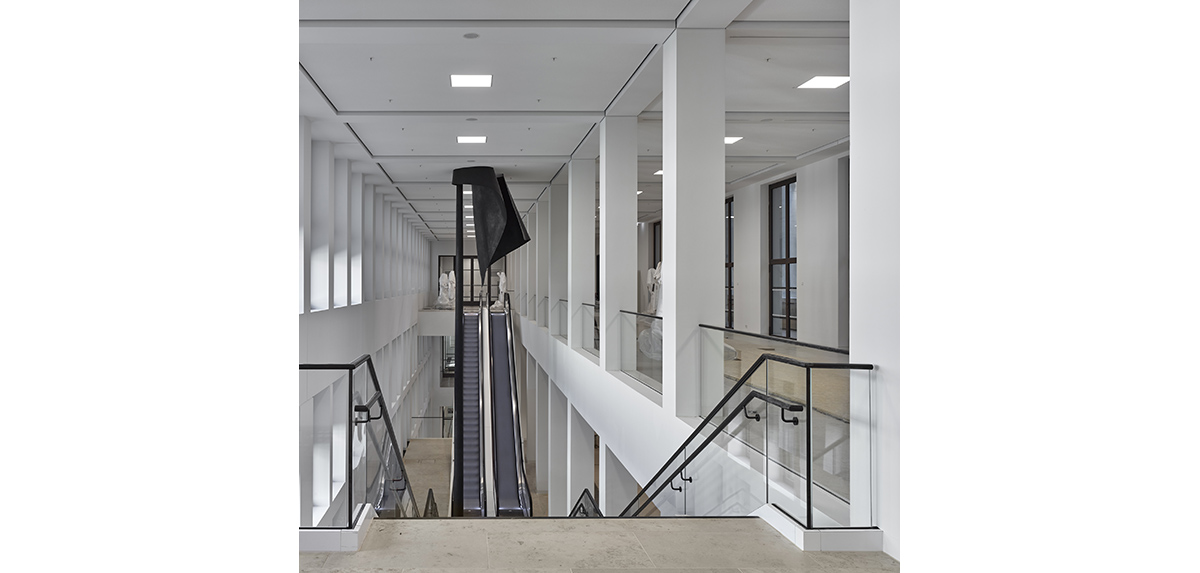BERLIN PALACE – HUMBOLDT FORUM
Competition Project 2008: Franco Stella collaborator: Michelangelo Zucchini (winner project)
Executive Project and Realisation management: Franco Stella Humboldt-Forum PG (Franco Stella Architetto, Hilmer & Sattler und Albrecht, Baumanagement Berlin)
Construction 2012-2020
A teacher of urban history
The Berlin Palace (Berliner Schloss), constructed since 1443 as the residence of the Brandenburg princes, was partially transformed at the beginning of the 18th century into the baroque palace of those same sovereigns, who in 1701 became kings of Prussia and in 1871 also German emperors. Damaged by the Second World War II bombings, the Berlin Palace was lastly razed to the ground for ideological reasons in 1950 by the holders of political power of the GDR. The area 'liberated' from the Palace, first used as Berlin's Red Square, from 1975 was partially occupied by the Palace of the Republic, remained in use until the fall of the GDR and demolished twenty years later.
The now reconstructed Baroque facades of the Berlin Palace reveal that it was the firstborn in its urban context and therefore suggest that it was the reference for the main places and buildings of the monumental historic Centre of Berlin: in particular for the triumphal axis Unter den Linden, that goes from the Palace to the Brandenburg Gate, or for the Museum Island, raised in its ‘’garden of delights. In the 'city of representation' of the Prussian sovereigns, of which it had been the director, the Berlin Palace returns as teacher of urban history.
A combination of re-constructed Old and new-constructed Modern
The new Berlin Palace – the "meeting place with the cultures of the world” dedicated to the Humboldt brothers – is a baroque and modern building, unitarily conceived.
It appears as an addition of completed places, made of re-constructed Old and new-constructed Modern. The Old is the part of the lost Palace, which was redesigned at the beginning of the eighteenth century by Schlüter and Eosander (a "masterpiece of the European Baroque", with Schinkel's words), and its nineteenth-century dome designed by Stüler. The New is intended as completion of a possible ideal building, starting from the real one. Except for the style, it seems that the New was born together with the Old, as if they were part of the same typological and urban fact.
The reconstruction, decided by the German Parliament in 2002 and confirmed by the 2008 Competition program, concerns the stereometry of the baroque palace, and its facades facing the city and the eastern courtyard, and the only stereometry of the dome; in addition, by decision of my project, the atrium and the facade of the three portals to the western court (Eosanderhof) and the facade of the dome were also 'faithful to the original' reconstructed.
The new construction consists of five new buildings: one outside, in the area of the late Gothic and Renaissance buildings of the Palace, the other four in the area of the main internal courtyard, the Eosanderhof.
Palace, City Gate, Piazza and Theater are the universally known and recognizable places that inspire the architecture of the Old and New: both outside, that of the building, and inside, that of its three courtyards.
A palace with six portals-city gates and three courtyard-squares
The new building facing the Spree, is intended as the 'fourth wing' of the reconstructed Baroque palace, completing Schlüter's original idea of transforming it into a unitary building, following the example of the Italian Renaissance and Baroque ones. The size and the figurative principles of the façade are similar to those of the three reconstructed wings: by virtue of the extraordinary size of its window openings, in particular their depth of over a meter, the front on the Spree looks like a 'facade of loggias', which suggests the public character of the building.
The internal new buildings complete the Schlüterhof as a theater-square and realizes two new courtyard-squares in relation to the portals rebuilt as City gate: the Schloss-Passage, whose new 'colonnaded way' remember an ancient Roman forum, and the Große Foyer, that evokes the Theater with the reconstructed triumphal arch’-portal as the ' scenae front' and the new galleries as the lodges for spectators.
The new Berlin Palace can be described as a 'city in the form of a palace', designed both for millions of visitors from around the world and for the daily life of thousands of citizens. Through its always open portals, the external squares mixes with the internal courtyards in a grandiose public space in the heart of Berlin.
The facade of walls and columns
The façade, both the ancient and the modern, often presents the combination of wall and columns, with distinct functions: the wall for the actual construction, the columns for the ornament, that ornament which in the classical tradition gives dignity to the building and décor to the city.
The modern one as well as the baroque facade often presents the combination of walls and columns.Both walls, baroque and modern, are a three-layer construction: a reinforced concrete building-supporting wall, a thermal insulation, the facade-wall. The ‘baroque facade’ is a brick wall with an average thickness of 65 cm: a self-supporting construction (and not a hanging 'mask'), with no apparent joints; the columns and architraves are reconstructed by adding pieces of natural stone with the same size and material of the original ones. The ‘modern façade’ is made of prefabricated elements made of white cement mixed with clear sandstone, the columns and architraves are monoliths.
The carved stones
Some stone artifacts have been restored, keeping their current fragmented condition; others, the most of them, have been reconstructed in their original completeness of form and matter.
The restored stones are variously mutilated figures, irreparably blackened by the patina of time: some have returned to outside where they were; others, too vulnerable to return outside, find their place in special exhibition spaces. Almost all the carved stones that were outside have been rebuilt: some, such as statues or high-reliefs, are unique pieces, made by the hand of the sculptor; almost all the others, such as friezes, frames, capitals or balustrades – altogether more than three thousand pieces – have been mechanically replicated starting from three hundred models, first of clay and then of plaster, made in the so-called Palace Factory (Schlossbauhütte) by numerous sculptors and stonemasons.
The internal spaces
The internal spaces have been redesigned and modernly equipped according to their new purpose; the arrangement of pillars and beams does not undermine the possibility of reconstructing places of particular historical-artistic value in the future. The total useful surface, distributed over four floors, is 42.000 m2: about a half for the collections of the Ethnological Museum and the Museum of Asian Art, and about 10.000 m2 for spaces of general public interest.On the ground floor are the Entrance and Stairs Hall, the Great Foyer, rooms for shows, meetings and temporary exhibitions, the Sculpture Hall, bookshops, restaurants and cafes; on the first floor are the exhibition spaces of a special Berlin Museum and of the Humboldt University; on the second and third floors, are the collections of the Ethnological Museum and the Museum of Asian Art, research and restoration laboratories. The underground floor – with the exception of an area of about 1500 m2, where the cellars of the old Palace can be visited– and the entire floor under the roof, are intended for technical equipment. Above the roof, in continuity with the underlying 'cube-north', there are a pavilion of a café-restaurant, surrounded by a terrace with a beautiful view to the city.

